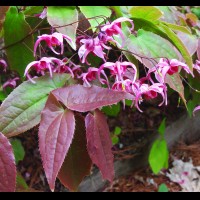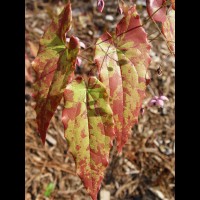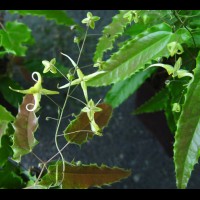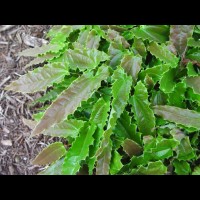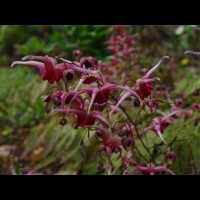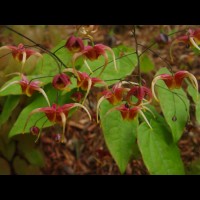These epimediums, although they grow for us in Zone 5b, are especially adapted to warmer regions including zones 8 & possibly 9. They grow well in slightly acidic, to alkaline soils.
Epimedium acuminatum
Epimedium acuminatum (Cc. 930001)
This species was originally collected by Mikinori Ogisu in the late 1970’s, and first introduced into the U.S in 1982. Several new introductions have arrived since, but this clone is the most dwarf at 8-10”. Relatively small evergreen leaflets, bright green in spring with shadows of purple flecks. The large flowers have white inner-sepals and grape-purple petals/spurs. Foliage 8-10" high at maturity.
Epimedium brachyrrhizum
Epimedium brachyrrhizum (Several clones/Cc. numbers)
Discovered in 1994 in Guizhou Province, China, it is one of the shortest species at only 6-8" tall, and among the largest flowered and earliest to bloom, with lavender-pink flowers nearly 2" across! New leaflets may be handsomely mottled with red-maroon in spring. Dark evergreen leaflets have a distinct corrugated surface, and many clones take on maroon overtones in fall. Not available this year.
Epimedium brachyrrhizum 'Karen'
Epimedium brachyrrhizum ‘Karen’ (Cc. 940526)
After years of trialing this plant against other superior forms of E. brachyrrhizum this stands out as the best for its prolific, large flowers in a soft shade of lavender-pink, combined with large leaves, heavily mottled with deep cranberry-rose in the spring. E. brachyrrhizum just happens to be one of my favorite Epimediums, so Darrell named this outstanding clone in my honor. 7” tall. Evergreen.
Epimedium davidii 'Emerald Sheen'
E. davidii ‘Emerald Sheen’ (Cc. 960085)
***2008 Cobblewood™ Introduction***
Extremely glossy leaflets are what makes this clone spectacular. It forms a mass of low growing, shiny foliage with smaller than normal, evergreen leaflets. The new spring foliage is tinted maroon. Flower stems are 12-24” tall with long spikes of many large, rich yellow flowers with tiny red inner-sepals. It is clump-forming, but produces occasional 3–5” rhizomes. Excellent for breeding, in that it passes the sheen of its foliage along to its offspring.
Epimedium davidii "Robust Forms"
E. davidii “Robust Form” (Several clones)
Like many species, E. davidii varies from one location to another. In 1999 Darrell helped to identify Epimediums purchased from China by a local nursery. Overall they were more robust and vigorous than any of the clones that he had collected in China, with flower stems from 18-24” high bearing the typical bright yellow blooms. They also had bolder evergreen foliage than any we have grown. The clones we offer have attractively red-mottled spring leaflets. Spreads slowly by occasional 4-8” rhizomes to form a mass 2’ wide in about 5 years under good growing conditions.
Epimedium dolichostemon
Epimedium dolichostemon Og. 81010 (Cc. 980078)
Narrow, evergreen, medium-sized arrow-shaped leaflets, heavily mottled with burgundy in the spring. Each small uniquely shaped flower has beautiful, reflexed, white inner-sepals and red petals with short, strongly curved spurs. 18” tall. In 1998, Robin White generously shared a blooming plant.
Darrell was awestruck the first time he saw slides of this clone. Lois Himes, garden assistant to Harold Epstein, took them of a plant exhibited by Robin White when she accompanied Harold to a 1995 Royal Horticultural Society show in London. It is far superior to the Ogisu clone (Og. 81011-- which is unfortunately terribly virused) making the rounds in the U.S.
Epimedium epsteinii
E. epsteinii (Several clones/Cc. numbers)
Discovered in 1994 and named after an outstanding plantsman—the late Harold Epstein. For half a century he grew Epimediums to perfection in his garden “La Rocaille” in Larchmont, NY.
This species has the widest sepals in the genus, nearly 1/2" across and slightly longer, pure white and a striking contrast to the reddish-purple spurs and cup. There are 10 (usually) to 30 of these medium-large flowers per stem. 6-10" tall with medium-sized, dark glossy evergreen leaflets. Spreads 6-8" a year forming a dense low groundcover. Benefits from some winter mulch in Zone 5.
Epimedium leptorrhizum Y44
Epimedium leptorrhizum Y44 (Same clone/Sev. Cc. num.)
From Guizhou Province in China, its large light lavender-pink flowers and medium-sized leaves are similar to those of E. brachyrrhizum-- elongated and arrow-shaped, with a corrugated texture. However, it spreads by thin rhizomes that grow 8”+ a year with foliage 6-8” tall. Forms a thick, low evergreen groundcover. Reddish fall color. Evergreen.
Epimedium leptorrhizum 'Hubei Treasure'
Epimedium leptorrhizum ‘Hubei Treasure’ (Cc. 001259)
***2005 Cobblewood Introduction***
Traveling along the Sichuan/Hubei Province border in China on a transitional day between target locations in November of 2000, Darrell stopped to stretch his legs. There he found an Epimedium in the cracks of a short cliff along a farmer’s field. With long hairs on the leaves and long rhizomes, he identified it as E. leptorrhizum, and collected a few samples. Fortunately this clone has larger flowers with near-white spurs backed by rich pink inner sepals, a striking deviation from the typical pale lavender-pink blooms of this species. The evergreen leaves are larger than those of the species. Spreads by 2-4" rhizomes.
Epimedium myrianthum
E. myrianthum (Several clones/Cc numbers)
Although the flowers of E. myrianthum are tiny, with over 100 flowers per stem, they create a billowy mass. White inner-sepals with yellow petals, and iridescent blue-black outer sepals enclosing the flowers in tight bud. Large, glossy, arrow-shaped evergreen spring leaflets are often lightly mottled with maroon. Shadows of that spring foliage mottling often reappear in the cool temperatures of fall. 18-20".
Epimedium myrianthum 'Mottled Madness'
E. myrianthum ‘Mottled Madness’ (Cc. 940110)
***2000 Cobblewood Introduction***
Of all of the plants and seedlings we have grown of this species, this clone stands out for its dark spring coloration. Large leaflets are heavily mottled for a month during spring, like a burgundy form of army camouflage. While the color eventually turns to green, it usually reappears once the temperatures dip in fall, and lasts through the winter in mild climates where the leaves remain evergreen. Bright airy panicles hold tiny white flowers that emerge from iridescently blue-black buds. 8-12”. Native to China.
Epimedium ogisui
Epimedium ogisui (Several clones/Cc. numbers)
Named in 1993 by Professor Stearn after Mikinori Ogisu, who discovered it in China in 1992 growing beside a waterfall. Darrell collected a few divisions at that same waterfall in 1996. Although described as pure white, the inner-sepals are usually pale pink. A cliff dweller in its native habitat, the flower stems spread out nearly horizontally holding large flowers. Medium-sized evergreen leaflets are glaucous, uniquely oval-shaped often with red spring coloration. Spreads by 6-8” long, thin rhizomes. USDA zones 6-9.
Epimedium platypetalum
Epimedium platypetalum (Several clones/Cc. numbers)
Native to China, 12 to 15” stems carry 10 to 20 dainty yellow bells suspended like tiny shuttlecocks, backed by tiny, white or reddish inner-sepals. The delicate blooms are held aloft on upright stems rising above small, rounded leaflets. Spreads by 8-12” long rhizomes, forming a low groundcover. Small, rounded, and slightly flecked new spring leaflets have few spines. While evergreen, the leaves flatten in the winter and are not very ornamental during that season. A particularly drought tolerant species.
Epimedium pubescens "Shaanxi Forms"
Epimedium pubescens “Shaanxi Forms”
(Several clones/Cc. numbers)
Epimedium pubescens is generally hardy from Zone 6 south, but these clones from Shaanxi Province have proven hardier, growing well in Zone 5. Forms a leafy clump 12” tall/wide with the flower panicles reaching to 16”. Medium-sized, evergreen spring leaflets are flecked with crimson, and mature to a glossy dark green with spiny margins. Starry flowers are borne in large airy panicles with 1/2” long, narrow, white reflexed inner-sepals and tiny orange-yellow spurred petals. Slightly spreading by 1-2" rhizomes.
Epimedium sp. nov. 'Simple Beauty'
E. sp. nov. ‘Simple Beauty’ (Cc. 022728)
***2010 Cobblewood Introduction***
A new, as yet unnamed, species collected by Darrell in China that is one of his most favorite. It is a simple leaved seedling/clone of a species new to science that normally has 3 leaflets... and VERY rare as Darrell only found a few of them. The very large and simple corrugated evergreen leaves are just about the glossiest of all Epimediums and can reach over 6” long and 2.5” wide. The new spring growth has a slight flush of red with thin needle-like spines along the margins. Flower stems extend 4-5” above the foliage supporting large flowers with long, sulphur-yellow spurs and light green inner-sepals. Its thick, spreading rhizomes grow from 2- 8" a year. It has proven to be a great parent. Photos courtesy of Mark McDonough.
Epimedium truncatum
Epimedium truncatum (Several clones/Cc. numbers)
The large, evergreen leaflets of E. truncatum differ in that the usual two basal lobes are missing, as if snipped off by scissors! They have a smooth, semi-gloss finish and are held on 15" stems. Open panicles to 21” hold numerous tiny white-sepaled, yellow petaled flowers, covered with striking blue-black outer sepals in bud.
Epimedium wushanense "Spiny leaved forms"
Epimedium wushanense "Spiny Leaved Forms" (Several clones/Cc. numbers)
A beautiful Epimedium with very large, glossy, evergreen leaflets with large spines. Leaflets have good substance and are each up to 6" long, resembling a wildly serrated knife. This extreme spininess of the leaves reveals the relationship of Epimediums to the Barberry family.
Unlike most Epimediums where the individual flowers are spaced so that you can differentiate each bloom, these have abbreviated, congested heads of flowers, reminiscent of a lilac or hydrangea panicle. The large flowers have white sepals and butter-yellow cup and spurs. Unlike the typical E. wushanense, these variants are lower, leafier, with shorter bloom panicles and spread by 4" rhizomes. Many exhibit a black-purple-reddish tinge to the new spring foliage. Plants can reach a height of 12-15" . Spreads slowly.
Epimedium 'Domino'
Epimedium ‘Domino’ (Cc. 990614)
***2004 Cobblewood Introduction***
Absolutely stunning in the garden-- a true specimen epimedium. Long, showy panicles of creamy white flowers with an abbreviated maroon cup are highlighted against handsome mottled foliage in spring. Elegant elongated spring leaflets are sponge-painted in various shades of maroon. Deep reddish-purple outer sepals and dark purple pedicels. Forms a 12-14" mound of spiky evergreen foliage with soft spines, covered in a halo of long flower stems to 16”. May re-bloom and produce a second flush of mottled new growth to 18" under favorable conditions of humus-rich soil and adequate moisture.
Epimedium 'Enchantress'
Epimedium ‘Enchantress’ (Cc. 950021)
A stunning cultivar from Washfield Nursery in England, a result of Elizabeth Strangman’s cross of E. dolichostemon by E. leptorrhizum. Beautiful silvery-pink, medium-sized flowers bloom well above long, narrow, evergreen leaflets (up to 10" in height) with undulating margins. Rhizomes grow 2-4” a year. Reliable deep red fall/winter color.
Epimedium 'Hot Lips'
Epimedium ‘Hot Lips’ (Cc. 031434)
An E. acuminatum hybrid from Diana Reeck of the former Collector's Nursery, with multi-toned flowers of hot pink with the long spurred petals that are decidedly hotter than the broad sepals. Flower stems are tinged burgundy red. Long narrow foliage emerges a reddish pink. Given a bit of bright shade or moderate sun in the north, the plant can reach 20” high. Its bright blooms and bold semi-evergreen foliage draws your eye from quite a distance.
Epimedium 'Kaguyahime'
Epimedium ‘Kaguyahime’ (Cc. 950225)
From Japan (via Mikinori Ogisu & Robin White) comes this delicately beautiful hybrid of E. acuminatum and E. dolichostemon. 15-18” stems carry sprays of small flowers with dark reddish-purple spurs and light rose-pink inner sepals. Long, slender arrow-shaped, medium-sized leaflets are jagged edged and beautifully mottled with various shades of red in spring. Vigorous for an semi-evergreen Epimedium, it is one of my favorites, and is named after a popular Japanese folk princess.
Epimedium 'Lemon Zest'
Epimedium ‘Lemon Zest’ (Cc. 990617)
***2005 Cobblewood Introduction***
From low, dense rosettes of small, shiny, rounded semi-evergreen leaflets flushed bronze in spring, emerge many erect racemes up to 12-15” high of cheerful, bright lemon-yellow bells. A slowly spreading hybrid which throws occasional rhizomes. A hybrid created by Darrell Probst. Foliage to 6". Flowers to 12".
Epimedium 'Ninja Stars'
Epimedium ‘Ninja Stars’ (Cc. 030301) Plant Patent #29744P2
***2016 Cobblewood Introduction***
A vigorous hybrid of two as yet unnamed, handsome species with particularly nice foliage collected in Sichuan Province, China by Darrell Probst. Long, narrow, very evergreen spiny leaflets form a crown of foliage 10-12” tall. Long sprays of spidery sulphur-yellow flowers scatter above the foliage. The multi-branched, spreading rhizomes grow 4-6” per year. New leaflets display a light bronzy-pink on first and second growth flushes in spring.
Epimedium 'Pink Champagne'
Epimedium ‘Pink Champagne’ (Cc. 990618)
***2007 Cobblewood Introduction***
Perhaps the most all around beautiful Epimedium of those that Darrell has developed so far! Upright, heavy flowered panicles of pink and raspberry flowers float well above handsome, mottled foliage in spring. Medium pink sepals cap the top of each widely-arched spur. From the yellow spur tips that reveal their treasure of nectar, the color changes from white to a rich, berry pink, as if the cup was dipped in raspberry sorbet. Elongated, evergreen medium-sized arrow-shaped leaflets contrast purple mottling against a green background. A vigorous grower, it puts on an incredible show with occasional re-bloom if it is happy in its environment. 12" tall with flower stems reaching 16".
Epimedium x omeiense 'Akame'
E. x omeiense ‘Akame’ Og. 82001 (Cc. 970187)
(Synonyms: ‘Emei Shan’, ‘Rigoletto’)
Mikinori Ogisu collected this clone on Mt. Emei in Sichuan, which Professor Stearn used as the type specimen for his description of E. x omeiense. The brilliant blooms have cherry-red inner-sepals and bright orange and yellow spurs. The cup is most intensely colored and edged in yellow. Open flower sprays are held above large, dark, handsome, glossy sagittate evergreen leaves that sometimes turn maroon in fall. 12-15” tall. A showy late bloomer.
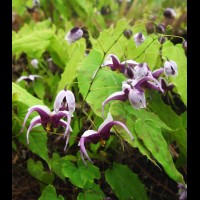
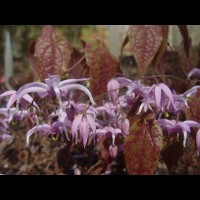
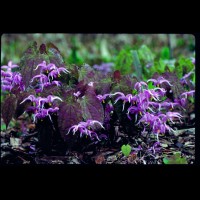
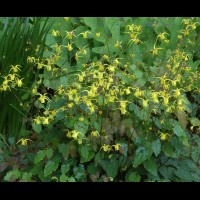
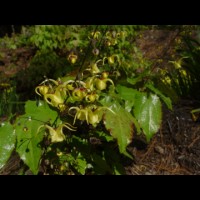
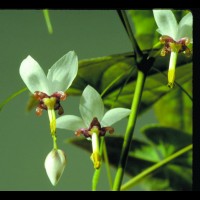
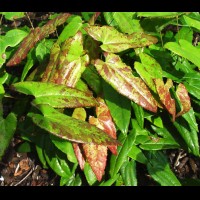
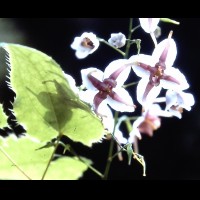
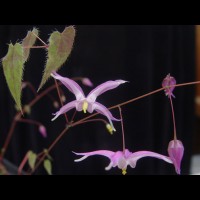
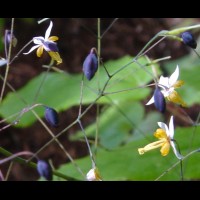
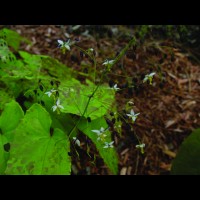
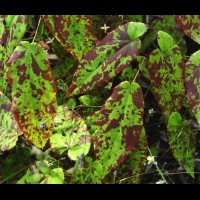
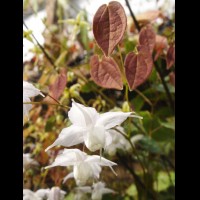
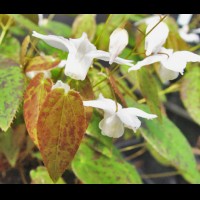
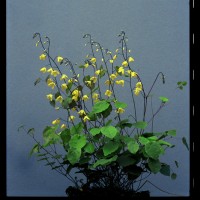
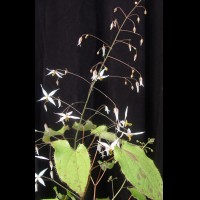
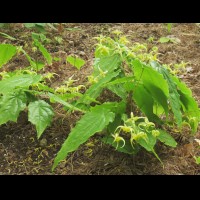
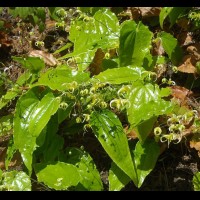
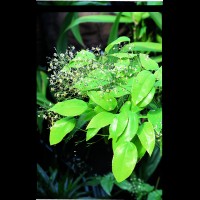
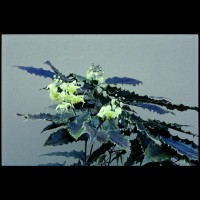
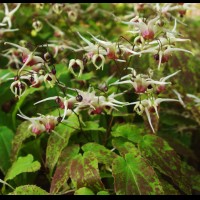
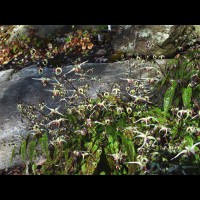
.jpg)
.jpg)
